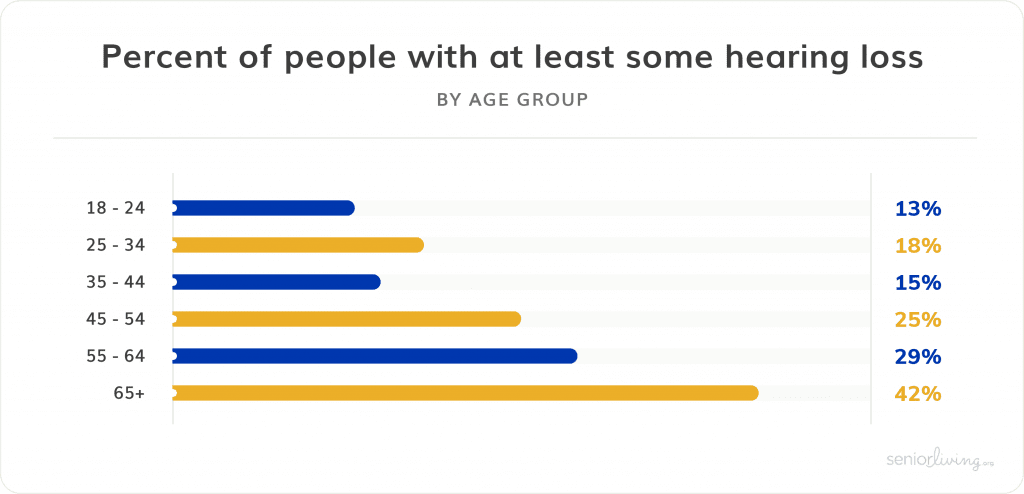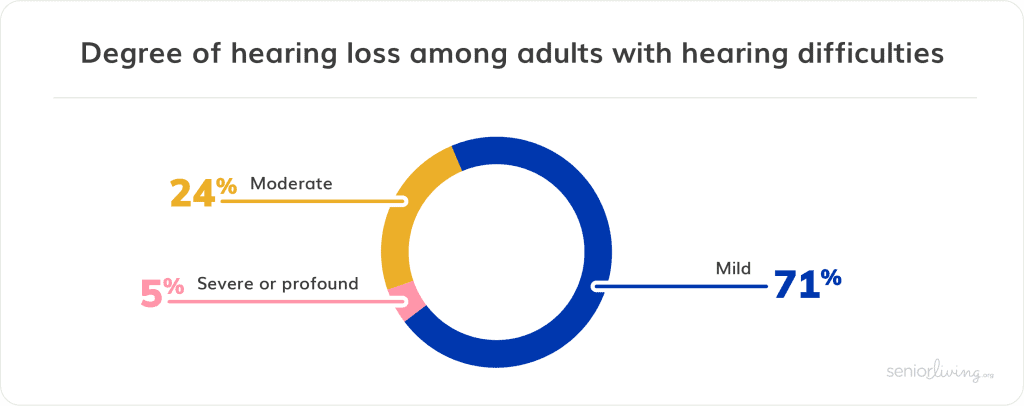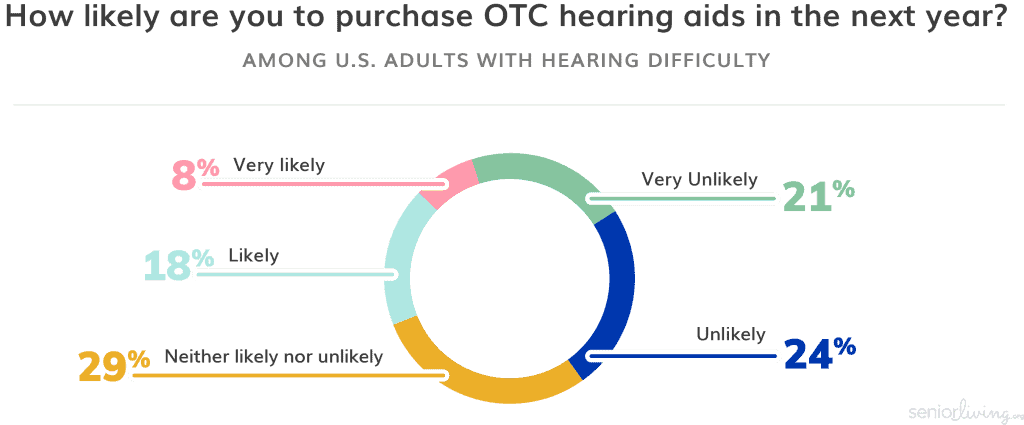Over-the-Counter Hearing Aids: Removing Barriers to Hearing Care in U.S.
According to our latest research, roughly a quarter of American adults report hearing loss. Still, millions have not invested in a hearing aid or even had their problem diagnosed by a doctor. That begs the question: why are so many Americans with hearing loss skipping out on hearing aids?
The Biden Administration thinks accessibility is a big part of the problem and took a significant step to make hearing aids easier to access at dramatically lower costs. In August 2022, the FDA rolled out a long-anticipated policy change: many hearing aids will no longer require a prescription and can be purchased over the counter online or in stores. That means fewer barriers to access and likely lower prices for millions of Americans who need them.
Over the last few years, SeniorLiving.org has studied hearing aid usage among Americans. However, this year we wanted to see how these new policy changes may help target undertreated hearing loss. To find out, we held a study of nearly 1,500 adults. Here’s what we found:
- Millions of Americans (roughly a quarter of U.S. adults or 62 million people) suffer from hearing loss. Of that group, about a third have not gotten hearing aids or even seen a doctor for their issues.
- High prices, difficulty accessing a doctor, and lacking prescriptions are among the biggest factors limiting hearing aid use for those who need them.
- Over-the-counter (OTC) hearing aids are sure to improve accessibility and price, but how large that impact will be is still hard to say. Our research estimates that 16 million people may buy an OTC hearing aid in the next year.
American Hearing Loss: Widespread and Undertreated
According to our study, nearly 25 percent of American adults struggle with hearing loss at some level. That figure is even higher for those over 55.
Most Americans with hearing loss (70 percent) report mild hearing difficulty. This means they have trouble hearing quiet conversations, mainly when there is a lot of background noise. Nearly a quarter have moderate hearing loss, which requires them to watch TV at a louder volume or have difficulty understanding speech. Around five percent have severe hearing loss, meaning group conversations and other activities are challenging at average volumes. Roughly one percent of those with hearing loss have a profound loss. This means assistive devices do little to help them hear, and they’re functionally deaf.
Why Adults with Hearing Loss Don’t Use Hearing Aids
About a third of adults with self-reported hearing loss never had it diagnosed by a medical professional. Additionally, almost half of adults who reported loss use don’t use assistive devices to help them with the problem, such as hearing aids or wireless headphones.
Most popular assistive devices for hearing loss
Among U.S. adults with hearing loss
| No assistive tech used | 48% |
|---|---|
| Closed captions or subtitles | 37% |
| Wireless headphones | 21% |
| Hearing aids or cochlear implants | 11% |
| Bluetooth adapter | 5% |
| Amplified telephone | 4% |
| Other | 5% |
There are a few main reasons why those with hearing problems don’t use hearing aids. First, many people with hearing loss felt they could manage without assistive devices. Around 40 percent of others didn’t have a prescription for hearing aids, and hearing aid price was a key obstacle for about 27 percent. Others said that their doctor didn’t find hearing aids necessary, or they used other technology to assist them, such as closed captioning.
Overall, cost was slightly more likely to be a barrier for people aged 55 or older than the general population. Compared to last year, people aged 55 or older were also slightly more likely this year to say that they didn’t use hearing aids because of the cost. This could be due to many factors, including inflation. However, this year, people in the 55+ age group were less likely to feel they could manage without hearing aids.
Top reasons for not using a hearing aid
Among adults with hearing loss who don’t currently use a hearing aid
| All adults 18+ (2022) | 55+ (2022) | 55+ (2021) | |
|---|---|---|---|
| I can manage without one | 61% | 60% | 70% |
| I have not been prescribed one by a doctor/audiologist | 39% | 34% | 42% |
| Too expensive | 27% | 31% | 26% |
| My doctor deemed it unnecessary | 6% | 9% | 10% |
| I have other technology to assist me | 4% | 5% | 3% |
| I just don't want one | 17% | 16% | 18% |
| I find them uncomfortable | 5% | 4% | 3% |
Note: Multiple responses allowed
Additionally, we know that the stigma surrounding hearing aids keeps many Americans from enjoying an easier, more empowered life. Dr. Ruth Reisman, an audiologist who sat down with SeniorLiving.org to discuss the recent changes from the FDA, said, “A lot of people don't want the social stigma of being seen with [a hearing aid].” She said that some people simply don’t like how they look or fear that others would judge them for having a disability.

However, Dr. Reisman assures that hearing aids are worth the investment, citing considerable changes in the quality of life for adults who make the switch. In addition to the practical benefits of improved hearing, she said there tends to be a positive impact on rates of depression and other mental health challenges, likely due to smoother socializing and a greater sense of independence.
Pro Tip: Interested in purchasing a pair of hearing aids? Visit our guide to the best hearing aids in 2025.
While enthusiastic about OTC hearing aids, Dr. Reisman still recommends those with hearing issues visit an audiologist. She says a doctor can help diagnose differences in hearing loss between the two ears, physical trauma or ear diseases, or improper hearing aid placement – all of which can’t be done at home. Even with a doctor’s visit, the new policy should save Americans money and make the process easier.
Will OTC Hearing Aids Make an Impact?
Millions of American adults with hearing loss would benefit significantly from using hearing aids. The question is whether these policy changes would help increase access to assistive devices.
When it comes to price, hearing aids should become less expensive for those with mild to moderate hearing impairment. OTC hearing aids are expected to cost between $300 and $500, a major drop from the current $1,000 to $5,000 range for prescription hearing aids.
>> Related Reading: Audien Hearing Aids Start as Low as $89
Additionally, access will be greater for those who don’t want to or cannot visit an audiologist. Doctors' visits carry their own costs and create major obstacles for those who do not have health insurance. Even with insurance (including Medicare), hearing aid examinations or fittings aren’t always covered.
These are all reasons for optimism that millions of Americans with untreated hearing loss will soon enjoy a greater connection with loved ones and higher quality of life. While federal officials are reluctant to say just how significant that impact will be, government estimates predict upwards of $2,500 in total long-run savings. Our research indicates that 16 million people are convinced and plan to purchase an OTC hearing aid in the coming months.
A Better Deal for Hearing Aids: Music to American Ears
Americans have long struggled with hearing aid accessibility. Purchasing hearing aids has historically been inconvenient, expensive, and difficult for millions of Americans without easy medical access or thousands of dollars to spend. The change to FDA policy, which will allow for a class of OTC hearing aids, seeks to change that.
The initial data is promising: OTC hearing aids will likely improve competition, access, and price for Americans with mild to moderate hearing loss, who comprise over 90 percent of the hearing impaired. Though difficult to predict how the OTC hearing aid market will mature, cost savings could well be in the thousands of dollars.
Our Data
SeniorLiving.org conducted an online study of 1,437 adults living in the U.S. aged 18 or older. Six hundred nine were 55 or older, and 828 were between 18 and 54. Seven hundred-eleven were women, 718 were men, and eight were non-binary or did not report their gender. Respondents were asked to self-report whether or not they experienced hearing loss and to what extent. Not all respondents had been officially diagnosed by medical professionals with hearing loss.



